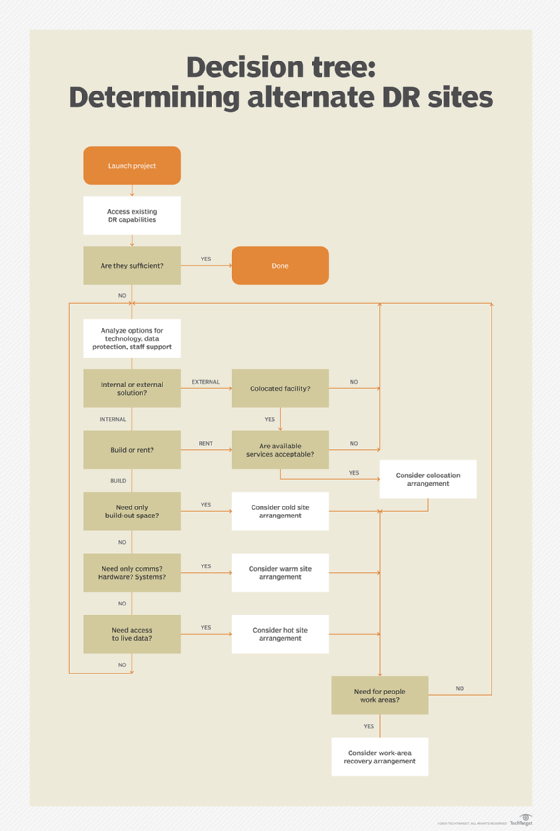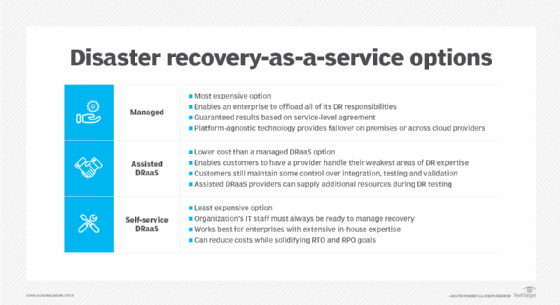warm site
What is a warm site?
A warm site is a type of facility an organization uses to recover its technology infrastructure when its primary data center goes down. A warm site features an equipped data center but no customer data.
The warm site has some or all the IT equipment found in a typical primary data center, such as software and hardware. After a disaster at the primary site, an organization introduces customer data and may install additional equipment at the warm site.
A warm disaster recovery (DR) site is important for business continuity because it enables an organization to keep running in the event of an unplanned incident and prevents further data loss. Information about the site is incorporated into the organization's DR plan.
Warm sites vs. hot and cold sites
An organization with a relatively short recovery time objective (RTO) uses a warm site, as it requires some setup but less than a cold site and more than a hot site. A warm site is also a good candidate for bringing up nonessential systems that don't require the immediate restoration that mission-critical systems do.
Other considerations for deciding on a hot, warm or cold site include funding, staffing, and volume and type of data. A hot site is the costliest option, while a cold site is the least expensive.
A hot site is a fully functional data center with hardware, software and customer data. It also includes staffing to manage and monitor the equipment. The hot site is ready for operation immediately following a disaster and is designed for mission-critical data and for an organization that can tolerate little to no downtime.
Replication or mirroring ensures that an organization has data ready to run at a hot site. If the business is big enough and has multiple data centers, it may use one of those as a hot site. While a hot site is the most expensive option, it is also the easiest to get running.
A cold site features infrastructure to support IT but does not have technology until a disaster hits and the organization brings it in. With a cold site, the organization is essentially just renting the space without equipment. It is the cheapest choice of the three but is only for an organization or specific data that can be down for an extended period because it takes a comparatively long time to get running. An organization can also use a cold site to supplement its hot or warm site during a long-term disaster.
Though there are many differences among the three site options, they all provide a secure, off-site space for recovery, not affected by the disaster. Determining which site is best for an organization is a process that requires time, management buy-in and proper analysis of all the necessary information.

How warm sites work
A warm site essentially features no production work until a disaster. Servers are set up in advance but don't contain databases. Ideally, the servers and storage at a warm site are at least similar to the servers and storage at the primary data center for performance and logistical benefits.
During a disaster, IT brings in the organization's backup data and any additional equipment needed to get running. The organization may pull down data from the cloud -- for example, using DR as a service (DRaaS) or backups stored on media, such as backup tape, that weren't affected by the outage at the primary data center. It's critical for an organization to know which data it will recover at the warm site -- some information is more urgent to restore.
The organization must also consider how it will bring data back to the primary data center once the disaster is over. If the organization uses the warm site for days, that could mean the creation of a large volume of data.
Types of warm sites
A DR site is internal or external. An organization builds an internal site and owns it, while a third party owns and operates an external site.
Benefits of an internal site include management and security control. Drawbacks include the cost to build it and run it. An internal site typically provides for a quicker RTO than an external site.
At an external site, management is left to the provider. This can help an organization that lacks staffing and resources to manage the backup center.
An organization may have the external site all to itself, or it may be a colocation facility, where multiple organizations rent space. If the external site contains multiple organizations, in the event of a widespread disaster, one risk is a crowded, bottlenecked space and unavailable or slower resources. At the same time, those other organizations could also provide assistance in the form of knowledge or contacts.
Another option is a mobile recovery site. This arrangement typically involves an outfitted trailer that is set up in the area of the disaster. An organization should factor in the amount of time it takes for the mobile unit to arrive at the desired location.
The cost implications of maintaining a warm site
The decision to maintain a warm site involves a careful analysis of cost implications compared to the potential financial impact of downtime. While warm sites offer a more budget-friendly alternative to hot sites, organizations must consider the ongoing costs of equipment, infrastructure and potentially leased space.
Balancing these costs against the potential loss of revenue, reputation and customer trust during an extended downtime is crucial when making DR planning decisions.
The evolving role of cloud computing and DRaaS
The landscape of DR has significantly shifted with the advent of cloud computing and DRaaS. These technologies have transformed warm sites from physical spaces requiring manual setup to potentially virtual environments that can be activated quickly and scaled as needed.
Cloud services offer the flexibility to create on-demand warm sites that can serve as either warm or hot sites, depending on the organization's needs, significantly reducing the time and cost associated with traditional physical DR sites.
DRaaS has emerged as a pivotal solution, providing organizations with the ability to replicate and host physical or virtual servers to provide failover in the event of a humanmade or natural catastrophe. This approach not only simplifies the DR process, but also ensures a more rapid return to normal operations, with cloud environments offering the added benefit of geographic diversity to protect against region-specific disasters.

Reducing reliance on physical sites with cloud-based recovery options
The trend toward cloud-based recovery options is reducing the reliance on physical warm sites. Modern DR strategies increasingly use cloud services to create flexible, efficient and cost-effective solutions that can be rapidly deployed.
This shift enables organizations to minimize their investment in physical infrastructure, while maximizing their ability to recover from disruptions.
Other emerging technologies and methodologies for efficient disaster recovery
Emerging technologies and methodologies, such as automated failover systems and machine learning algorithms, are enhancing the efficiency of DR. Automated failover systems can significantly reduce the time to switch to a warm site by automatically detecting failures and initiating the failover process.
Machine learning algorithms can predict potential failures before they occur, enabling preemptive action to avoid downtime. These advancements, coupled with sophisticated DRaaS offerings, are setting new standards for rapid, efficient DR.
Security and compliance considerations for warm sites
Integrating cybersecurity measures into the DR plan is essential, particularly in protecting backup data and ensuring secure access to the warm site. This includes encrypting data in transit and at rest, implementing extensive access controls and regularly updating DR protocols to address emerging cybersecurity threats.
By prioritizing cybersecurity, organizations can ensure that their recovery efforts are not compromised by data breaches or other security incidents. Additionally, compliance with data privacy laws, such as the General Data Protection Regulation and California Consumer Privacy Act, are a critical consideration in DR planning.
Organizations must ensure that their data handling and storage practices at the warm site comply with these regulations to avoid potential legal and financial repercussions. This includes conducting data impact assessments, ensuring data is stored and processed in accordance with legal requirements, and maintaining transparent data processing activities.
Checklist for setting up and maintaining a warm site
While the exact considerations, tasks and planning vary from organization to organization, the following can serve as a general checklist to help business leaders plan or refine their existing DR strategy for a warm site:
- Assess needs. Determine the organization's RTO and recovery point objective (RPO) to decide on the required capabilities of the warm site.
- Choose the right location. Ensure the site is geographically distant from the primary data center to avoid being affected by the same disaster. To that end, it should not be on the same power grid as the primary data center. However, an organization needs to take latency issues, such as network connectivity, into account and make sure the site is not too far away. Location decision considerations also include staffing and cost.
- Invest in adequate technology. Equip the site with necessary hardware and software that mirror the company's primary environment, enabling a smoother transition.
- Ensure appropriate data is carried over to the warm site. It's important to have necessary contact and resource information ready at the DR site. An organization in the middle of a recovery does not want to spend time looking for contacts or any other relevant information since that material can be compiled in advance.
- Secure the data. Implement encryption, access controls and other cybersecurity measures to protect data during the recovery process.
- Ensure compliance. Make sure the warm site operations comply with relevant data privacy laws and regulations.
- Employ cloud services. Consider using cloud computing and DRaaS solutions to enhance flexibility and reduce setup time.
- Plan for data recovery. Develop a clear plan for how data is recovered and restored, including the use of cloud services or backup media. If it's a brick-and-mortar warm site, it's important to have a diagram of the recovery site and how it functions, plus clear directions for how to get there.
- Test regularly. Conduct regular tests of the DR plan to ensure the warm site can be activated quickly and efficiently.
- Update the plan. Regularly review and update the DR plan to address new threats, technologies and business needs. Proper planning involves constantly reviewing the contents of the plan and the site. A test at the site is a good way to ensure it works in a recovery situation.
- Train the team. Ensure the team is trained on the DR plan and knows how to activate and operate the warm site when needed.
By incorporating these modern considerations and following the checklist for setting up and maintaining a warm site, organizations can develop a comprehensive DR strategy that minimizes downtime and ensures BC in the face of disruptions.
Resiliency during and after a crisis depends on many factors, such as high availability and resiliency. Explore why a DR strategy needs both high availability and resilience to be effective.



